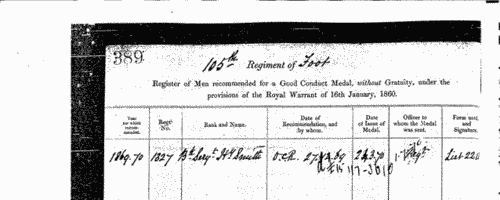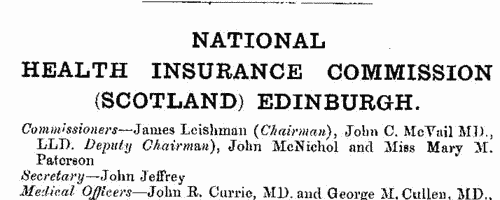Varker Surname Ancestry ResultsOur indexes 1000-1999 include entries for the spelling 'varker'. In the period you have requested, we have the following 6 records (displaying 1 to 6): Buy all | | | Get all 6 records to view, to save and print for £36.00 |
These sample scans are from the original record. You will get scans of the full pages or articles where the surname you searched for has been found. Your web browser may prevent the sample windows from opening; in this case please change your browser settings to allow pop-up windows from this site.  Sailors on board H. M. S. Swiftsure
(1796-1798) Sailors on board H. M. S. Swiftsure
(1796-1798)
His Majesty's ship the Swiftsure took part in the destruction of the French fleet in Aboukir Bay at the mouth of the Nile ('the Battle of the Nile') on the evening of the 1st and morning of the 2nd August 1798. This is the muster book for 1 August to 30 September 1798: being a continuation book in a series covering wages and victualling from May 1796, it also includes the names of some men who had died, deserted or been discharged from the ship from then to August 1798. Of the ship's complement of 590, this index covers the sailors, volunteers, and boys, as well as the supernumeraries and the retinue of William Parker, Rear-Admiral of the Red: but not the marines, or the French prisoners taken after the battle. Usually each man's entry gives his birthplace, and also his age on entering the ship.VARKER. Cost: £8.00.  | Sample scan, click to enlarge

| Owners of Merchantmen
(1822)
The Society for the Registry of Shipping was instituted in 1760, and published an annual register and supplement. The annual register consisted of an alphabetical list of ships surveyed for insurance in Britain and Ireland, together with an alphabetical supplement. The society maintained a Registry Office at which alterations and additions were notified, and members delivering their registers when called for had them updated and returned on the following or the ensuing day. Each ship was given a number within each letter of the alphabet: ships' names were not unique, so within each name a ship was identified by the name of the captain or master at the time of the last survey. Then abbreviations indicate the type of vessel (Bg, brig; Bk, barque; Cr, cutter; Dr, dogger; G, galliott; H, hoy; K, ketch; S, ship; Sk, smack; Sp, sloop; Sr, schooner; St, schoot; Sw, snow), and whether sheathed (s) and/or doubled (d) with copper (C) and iron bolts (I B) or over boards (W & C), patent felt (P F), copper fastened (c f), copper bolted (c b), or copper repaired (C rp) sometimes with a date, such as (18)18. The third column, reserved for masters' names, is not particularly wide; with short surnames, an initial will be given; but longer surnames omit the initials, and even longer surnames are abbreviated. It will be borne in mind that these are the names of the masters not (necessarily) in 1822, but at the time of the last survey. Often new masters had been appointed by the time of re-survey, and their names are added in slightly smaller type under the original master's names in the third column. In the fourth column is the tonnage: where there is a blank under the number this indicates that the ship had two decks; more often the letters S D (B) for single deck (with beams); D W for deep waist; S D W single deck with deep waist; B D W single deck with beams and deep waist. Underneath the entry may run references to recent repairs: Cl. clincher built; Drp. damages repaired; grp. good repair; len. lengthened; lrp. large repair; N. (new) B. bottom, D. deck, Kl. keel, Sds. sides or UW. upper-works; rb. rebuilt; rsd. raised; Srprs. some repairs; or trp. thorough repair. In italics, the timber of the ship is described - B. B., black birch; C., cedar; H., hazel; Hk., hackmetack; J., juniper; L. O., live oak; M., mahogany; P., pine; P. P., pitch pine; S., spruce; W. H., witch hazel; W. O., white oak. The fifth column gives the place that the ship was built. For foreign ships this may be as vague as 'Dutch' or 'French'; but nothing in this record specifically indicates the nationality of ship, master or owners, except that an A. under the owner's name indicates that the vessel was American property. The sixth column gives the year of the ship's age; a few were still sailing after 30 or 40 years. The seventh column gives the owner's name, abbreviated in the same way as the master's name. Where the master was the owner, the word Capt. will appear. With vessels owned abroad, the name in this column is sometimes that of the port of origin, not the surname of the owner. Where there has been a change of owner by the time of re-survey, the new name is put underneath in smaller type. The printer sought to avoid confusion by aligning names of ports to the left and surnames to the right, but that leaves longer names doubtful. The eighth column gives the feet of the draught of water when loaded. The ninth column shows the destined voyage for which the survey took place, with the port of survey abbreviated (Be., Belfast; Br., Bristol; Co., Cork; Cs, Cowes; Da., Dartmouth; Du., Dublin; Eh, Exmouth; Ex., Exeter; Fa., Falmouth; Gr., Greenock; Hl, Hull; Hn, Harrington; La., Lancaster; Lh, Leith; Li., Liverpool; Lo., London; Ly., Lynn; Mt., Maryport; Po., Poole; Ph, Portsmouth; Pl., Plymouth; Sc., Star-Cross; Tn., Teignmouth; Tp., Topsham; Wa., Waterford; Wn, Whitehaven; Wo., Workington; Ya., Yarmouth), and the letter C where the vessel was a constant trader between the two ports. The tenth column gives the classification of the vessel (A, first; E, second) and its stores (1, first; 2, second) and the year of survey, e. g. 09 for 1809, or, if surveyed during 1821, the month, e. g. 3 for March. Where the vessel has been re-surveyed, the classification letter and number will be repeated or revised in the final column. The sample scan is from the main list. This is the index to owners in the main list and the supplement.VARKER. Cost: £6.00.  | Sample scan, click to enlarge

|  Outstanding soldiers of the 28th regiment of Foot
(1860-1870) Outstanding soldiers of the 28th regiment of Foot
(1860-1870)
The 28th (The North Gloucestershire) Regiment of Foot embarked for Turkey in 1854, and took part in the Crimean War; then to Malta in 1856; and thence to India. It was stationed at Ahmednuggur in 1860. The regiment returned to England in 1865, and in 1867 to Ireland: the depot was at Fermoy. In 1868 the troops were sent to Gibraltar. Each year just a handful of outstanding soldiers of the regiment were chosen for good conduct medals and gratuities: these are listed here. There were two lists, one for men recommended for the Good Conduct Medal without a gratuity, and one for gratuities - £5 to a private, £10 to a corporal, and £15 to a serjeant. Both lists are indexed here, and each gives rank, name, regimental number, date of recommendation and date of issue. (The sample scan is from the 105th foot)VARKER. Cost: £8.00.  | Sample scan, click to enlarge

| County Court Judgments: Cornwall
(1890)
Extracts from the Registry of County Courts' Judgments. These judgments were not necessarily for debt. In some cases they were for damages on properly disputed causes of action, but no distinction was made on the Register. Judgments settled otherwise than through the Court may appear, unless 'Satisfaction' was entered up within the fourteen days allowed for that purpose. These printed extracts include occasional notes giving more detail about certain cases, and also list Satisfactions entered on the Register.VARKER. Cost: £6.00.  | Sample scan, click to enlarge

| Civil Servants and Office Holders
(1913)
The Imperial Calendar gives lists of officials and office-holders throughout England, Wales, Scotland and Ireland
VARKER. Cost: £4.00.  | Sample scan, click to enlarge

| Boys entering Truro School
(1901-1954)
Truro College was founded 19 January 1880; the name was changed to Truro School in 1931. In 1954 this register of old boys was published, arranged alphabetically by surname and then christian name (or initials), in bold; then years of entering and leaving the school, and, in many cases, address as in 1954. Sometimes occupation is given.VARKER. Cost: £4.00.  | Sample scan, click to enlarge

|
Research your ancestry, family history, genealogy and one-name study by direct access to original records and archives indexed by surname.
|









